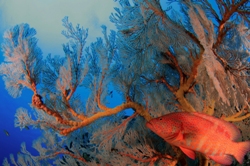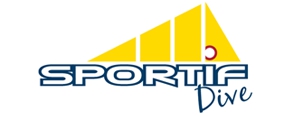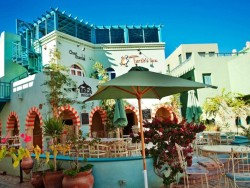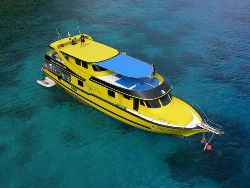2024 - 2025 Scuba Diving Holidays, Liveaboards and Learn to Dive Courses to the Maldives, Red Sea, Canary Islands, Far East, Caribbean and the Pacific.
Thailand Dive Sites - Thailand, Far East & Australia
Guide to Scuba Diving Sites in Thailand
The Similan Islands
Often rated as on of the best diving locations in the World, the Similan Islands are a National Park around 100 km Northwest of Phuket, Thailand.
 Made up of 9 islands, running North to South with numerous smaller rock outcroppings white sand beaches, tropical jungles and superb dive sites in aquamarine waters. Most of the islands are surrounded by rock formations below the surface, like stone giants offering homes to an incredible amount of sea life, with canyons running to 40m or more. A variety of topography incluidng caverns, swim throughs and sites called Elephant Head, Boulder City, East of Eden and Shark Fin Reef are as spectacular as you would image.
Made up of 9 islands, running North to South with numerous smaller rock outcroppings white sand beaches, tropical jungles and superb dive sites in aquamarine waters. Most of the islands are surrounded by rock formations below the surface, like stone giants offering homes to an incredible amount of sea life, with canyons running to 40m or more. A variety of topography incluidng caverns, swim throughs and sites called Elephant Head, Boulder City, East of Eden and Shark Fin Reef are as spectacular as you would image.
Koh Bon and Koh Tachai
These two uninhabited islands, located between the Similans and Surin National Park offer a variety of breathtaking dive sites - spectacular drop-offs, amazing hard and soft corals, and chance to see passing manta rays and whale sharks.
Richelieu Rock
Rates at the best dive site in Thailand. Located to the North east of Ko Tachai and close to Burma's southern border. This small rocky outcrop is adorned with soft corals and is home to an astounding variety of marine life with Stingray, Guitar Ray, Leopard Shark and large schools of Trevallies and Barracuda. A magnet for Whale shark it is one of the best places in the world to spot these gentle giants.
Raja Yai
About 1½ hours South of Phuket is a beautiful tropical island with a lot of good hard coral reefs, colorful shallow water coral gardens and a great opportunity for some enjoyable drift diving.There are several excellent dive sites particularly suitable for the beginner and snorkeler, making this island a favorite destination for everyone.
Raja Noi offers in addition to Raja Yai's attractions some truly spectacular sites with giant underwater boulders and scenery almost like the Similans and a great chance to see manta rays and whale sharks.
Shark Point
A small rock outcropping about 1½ hours East of Phuket, is a famous marine sanctuary due to its tremendous variety of marine life. Particular attractions you should look out for are the colorful soft corals and sea fans decorating the limestone pinnacle, the great range of tropical fish and the famous leopard sharks, found on the sandy bottom.
Anemone Reef
This submerged reef located not far from Shark Point is similar in character and you will be amazed at its extensive fields of sea anemones. Harmless leopard sharks are also to be found together with some massive schools of smaller fish and some larger pelagic such as tuna and barracuda.
Phi Phi Islands
3 hours due East of Phuket, the Phi Phi Islands are a famous destination even for those unaware of the great diving available. As a diver, you will find that the spectacular limestone cliffs above the water become sheer drop-offs and craggy coral encrusted landscape under the water with a rich and colorful diversity of marine life and even whale sharks are known to visit.
King Cruiser
On the 4th of May 97 King Cruiser, a 85 m catamaran passenger ferry, strayed off course and hit Anemone Reef ripping one of her twin hulls open. Subsequently King Cruiser sunk within an hour with no loss of life. With its multiple decks, great open passages and depths between 12 and 30 meters the King Cruiser is an ideal wreck dive site for all divers.
Koh Doc Mai
This small, jungle topped island lies halfway between Shark Point and Phuket. It provides some of the best wall diving in the area with sea fans, soft corals and colorful sea life decorating its underwater cliffs.
North Andaman Dive Sites
Similan - Bon - Richeliu + Surin - Richeliu - Similan
Anita's Reef - Barracuda’s Point, “Hin Muan Deaw”
The Thai name for this spectacular rock is “Hin Muan Deaw” and is the best way to describe how beautiful this rock really is, as it directly translates to “Whole roll (of film) rock”, as one can use an entire roll film solely on this rock. The reef slope falls from the reef flat at 15 – 35 ft (5 – 10 m) to the sand bottom at a maximum of 85 – 90 ft (26 - 28 m). Shallow coral gardens comprise huge pore and staghorn corals with small pinnacles. A big outcrop located on the southeast makes this dive site unique and attracts many photographers. Colorful soft corals, gigantic sea fans, and many species of hard corals surround this fantastic rock.
West of Eden
West of Eden basically comprises giant granite boulders that create nice canyons, with walls covered with colorful soft corals and giant sea fans. Some areas are characterized by rubble and sand slope falling to a depth of 100 – 115ft (30 - 35 m). The shallows are home to many reef fishes, and have stacked granite boulders covered with hard corals, soft corals, gorgonians and feather stars. This area is a nice place to look for macro subjects like nudibranchs and frogfish. Keep an eye out for cleaner pipefish and many banded pipefish in small crevices, as well as long-nose hawkfish perched in black coral bushes. The rubble and sand slope are good place to search for ribbon eels, dragonets and red fire gobies. Back at the reef, moray eels are quite common, as well as turtles and schools of angelfish. Occasionally, whitetip reef sharks cruise by.
Bon - Koh Bon West Ridge, Koh Talu
The wall, part of the Similan National Park, is decorated with various colorful soft corals and hard corals. From the ridge to the northeastern side are reefs that stretch along island. The reef slopes from a depth of 30 ft (10 m) down to a sandy bottom at 80 – 100 ft (25 - 30 m). The majority of corals here are hard corals, including staghorn coral and brain coral that are interspersed with a few big coral heads. To the northwest of the island, there is a submerged pinnacle. The pinnacle is at a depth of 60 – 150 ft (18 - 45 m) and is covered by an abundance of yellow soft corals and large sea fans. This site is a cleaning station for manta rays, so there is a high chance of finding at least one during a dive, particularly at the western ridge and northeastern outer reef. Koh Bon also has many kinds of sharks, such as leopard sharks and whitetip and blacktip reef sharks. Sometimes grey reef sharks swim by, and nurse sharks can be seen lying under coral heads. Schools of yellowtail barracuda, fusiliers, trevally, sweetlips and black and white snappers are all common in the area, as well as octopuses, sea snakes, and nudibranchs.
Tachi Reef – Leopard Shark Reef
Tachai Reef stretches through the eastern side of the island, going from the northeast to the southwest. The reef slope falls from 16 – 33 ft (5 - 10 m) to the sand floor at 82 – 98 ft (25 - 30 m). Hard corals cover the entire area, most of which are staghorn corals, pore corals, brain corals, and fire corals. In the southern part, the gentle slope becomes a steep drop-off that continues from the island down to 98 ft (30 m). Divers regularly see leopard sharks lying at the outer sandy area and sometimes in shallow areas. Large stingrays are found on occasion too. General reef fish include pufferfish, lionfish, parrotfish, and moray eels. At night, several species of crabs and shrimp come out to hunt. It is possible to see twin-spotted lionfish, a rare species of lionfish that tends to be shy and hide in crevices. Cuttlefish, nudibranchs and flatworm are also common.
Richelieu Rock – Hin Plo Naam
One of the most famous dive sites of Thailand, Richelieu Rock is an isolated pinnacle to the east of Surin Islands. Forming a horseshoe figure, the pinnacle fall steeply to the surrounding sand bottom at a maximum depth of 115 ft (35 m). The south side is a bay with a slope that gently falls to the deep, while the rest comprises sheer walls, groups of rock and numerous small caves that are home to various marine life. The majority of corals are colorful soft corals jostling against the wall, accompanied by huge sea fans, hard corals and sea anemones.
Due to the diversity of small and large creatures, Richelieu Rock is a paradise for underwater photographers. Ghost pipefish, frogfish, harlequin shrimp, seahorses, Janss pipefish are some of the smaller marine life that can be spotted here. Also, divers have often encountered cuttlefish mating. In addition, plenty of anemone fish species, particularly tomato clownfish, are regularly sighted. Different types of moray eels such as giant moray, zebra moray, and white-eyed moray are common. Pelagic fish swarming around the small outcrops include chevron barracuda, rainbow runners, and giant groupers resting on the sand floor are a common sight. Lastly, this site is famous in Thailand for being a hotspot for encounters with both whale sharks and manta rays.
Tachi Pinnacle – Twin Peaks
A solitary island located 20 km. north of Koh Bon, Koh Tachai has magnificent white sandy beaches with two interesting dive spots, southern pinnacles and eastern reef. Tachai Pinnacle or Twin Peaks are a pair of submerged pinnacles located 500 m south of Koh Tachai. The southern pinnacle is bigger, at a depth of 40 ft (12 m) from the top. It is a dome shape surrounded by large boulders. The sand bottom is at a depth of around 100 – 150 ft (30 - 45 m). To the west you will find large boulders, some of which have formed swim throughs. In the east, you will find stacks of small rock, most of which are cover by hard corals and sea whips. Colorful soft corals and sea fans dominate the northern area. The top of the pinnacle is a wide flat plain with bush and mountain coral. This huge pinnacle links to the small one with a sand patch at 80 ft (24 m). The smaller pinnacle comprises of a wide range of rock clusters and is home to large sea fans and corals, which are similar to the ones found in the southern pinnacle.
Manta rays visit this area for feeding and circling around the pinnacles. Some divers have encountered whale sharks as well. On the outer sand bed, divers can usually see leopard sharks, sometime three to four of them in the same dive. In addition, it is possible to find Jenkin’s rays, as well as whitetip sharks and blacktip reef sharks here as well. Swarm of chevron barracuda, bluefin trevally, batfish, snappers, and fusiliers are common here.
Elephant Head Rock - Hin Pusa, Hin Hua-ka-loak
Visible from the surface, Elephant Head Rock is the biggest pinnacle in the Similans. It is located 1.5 km south of Koh Similan. There are three large boulders that emerge above water. At this site, submerged boulders are piled up, forming sheer walls and swim-throughs that are covered with assorted colors of soft corals and sea fans. The site is surrounded by sand at a maximum depth of 115 – 130 ft (35 to 40 m).
One of the outstanding features of this site is the swim-throughs. In addition, cave walls are full of soft corals, creating plenty of magnificent scenery that makes you feel like you are swimming in an underwater valley. To the west of the giant rock is a sheer wall that falls to a depth of 130 ft (40 m). Divers have often seen whitetip and blacktip reef sharks outside the boulders. In addition, juvenile whitetip reef sharks can sometime be seen laying in the cracks of the boulders. In mid-water, schools of fish, including bluefin trevally, fusiliers and rainbow runners are common. Near the exposed boulders, giant trevally and great barracuda are a common sight. Also, divers may encounter large snappers and sweetlips in cracks, holes and swim-throughs.
Christmas Point
A cluster of submerged boulders, with the exception of a pinnacle at the surface that is located on the northwest ridge of Koh Ba-Ngu. Underwater, there are number of large stacked boulders that stretch from the island to a depth of 115 – 130 ft (35 - 40 m), which create an arch like swim-throughs at 80 ft (24 m). Colorful soft corals and sea fans cover the crevices. A hard coral garden made up of rows of staghorn and pore coral is located at a shallow depth of 30 ft (10 m).
Around the borders of the rocks and beyond, at a depth of 80 – 130 ft (25 - 40 m), you are likely to find leopard sharks, whitetip and blacktip reef sharks and other big fish such as Napoleon wrasse, great barracuda, giant trevally and tunas. At the swim-throughs, giant sweetlips and groupers can be seen hiding in crevices. School of fish including bluefin trevally, neon fusiliers, goatfish, and long nosed emperors are frequent visitors. Many small fish, such as purple fire gobies and red fire gobies are a familiar sight here. Ribbon eels, a rare species that camouflages on the sand like whip corals, can also be seen. Also, pipefish, nudibranchs, and porcelain crabs cab be found. It is possible to spot manta rays passing by as well.
Shark Fin Reef - Hin Phae, San cha-larm
A formation of granite boulders and hard corals to the southeast of Koh Pa-Yan. The site itself is approximately 1 km. long and lies from the northwest to the southeast. Normally three pinnacles can be seen from the surface, which gives the reef its name Shark Fin Reef. Boulders that fall steeply to 115 – 130 ft (35-40 m) and are surrounded by sand occupy the vast majority of the site. Due to the fact that the boulder formation is long, coral reefs have been divided into northern and southern areas. Both areas are steep and cliff-like. The northern area has more corals consisting mostly of staghorn coral and soft corals, combined with tiny rocks and sea fans. The southern side is made up primarily of sheer walls. Overall, at various parts of the reef, some pinnacles have stacked themselves on top of one another, forming many swim-throughs that divers can enjoy.
Near the sandy areas, you likely to find leopard sharks, whitetip and blacktip reef sharks, Kuhl’s stingrays and spotted garden eels. Furthermore, this site is one of the few areas in the Similans where you can see Napoleon wrasse and hump head parrotfish. Bigger than usual adult cube boxfish are often seen, particularly in the shallow waters of the east. Among the boulders, a lot of camouflaged marine life can be seen, including octopuses and devil scorpionfish. Manta rays can be spotted during the month of April and whale sharks have been report in the vicinity as well.
South Andaman Dive Sites
Koh 5 - Lepe - Hin Mung Hin dang - Phi Phi - Anemone Reef
Koh Haa-Lagoon Koh Haa No.2 and No.4
Located in the middle of Koh Haa group, the Lagoon is a 16 ft (5 m) deep area surrounded by a pair of small limestone towers (Koh Haa No.2 and No.4) to the east, and Koh Haa No.3 to the west. The south tower, covered with colorful soft coral, huge see fans, black corals, fields of anemones and orange cup coral, forms the south side of the islands, with the outer sand bottom at a depth of around 80 ft (24 m). A number of rocks are scattered beyond the wall, where divers may find snappers, and you will find hard coral scattered all around the sandy, sloped area connecting the two islands. The north tower is quite similar to the south, except things are on a larger scale.
Koh Haa No.3, a long island to the west of the lagoon. It is also another good dive spot, however, less famous than the two towers. This site is perfect for macro lovers. Because of the nature of limestone cliffs, there are many cracks and crevices along the wall, offering shelter to many small creatures like shrimp and crabs. Take a closer look at a sea fan, and you may find ornate ghost pipefish and cowries camouflaged among the fronds. Harlequin Shrimp and sea moths have been spotted between the two islands sometimes. Many species of nudibranchs make their home at the wall, and lobsters and squid can also be found here.
Koh Haa – Neua - The Chimney, Koh Haa No.1
Koh Haa – Neua is the northernmost island of Koh Haa group. Reefs surround this island with the north coast featuring a wall line covered with soft coral, sea fans and barrel sponges. A hard coral reef slope stretches from the southeast side to the east side of this island. The maximum depth at Koh Haa – Neua is 80 – 100 ft (25 – 30 m).
The most popular diving spot on this island is located on the south side, and it is characterized by stunning outcrops covered by dense growths of south corals and sea fans that create a dazzling swim through. At 50 – 60 ft (16 – 18 m), there is a grotto that leads to a chimney-like vertical hole – another highlight of this dive site. This chimney has two exits at a depth of 15 ft (5 m). Kuhl’s stingrays, moray eels, scorpionfish and puffer fish are common sightings. Leopard sharks have also been spotted in the sand beyond the reef. Divers should also take the time to explore crevices – you may find ornate ghost pipefish, or even rare species such as the tiger-tail seahorse. Eye – catching harlequin shrimp have also been found in the area.
Koh Haa – Yai - The Twin Cathedral
The biggest of the Haa islands is Koh Haa Yai. It is characterized by a steep cliff perpendicular to sea level that stretches all the way from above the water to depths of up to 100 ft (30 m). Koh Haa Yai is surrounded by reefs, and the most famous dive spot is the rock wall at the south side of the island, which ends in a sandy bottom at 80 – 100 ft (25-30 m) and is covered with a variety of soft corals, sea fans and hard corals.
There are two underwater caves on the southeast side. The entrance of the first cave is at a depth at 40 ft (12 m). As this cave gets narrower as you go deeper, cave penetration is not recommended unless divers have obtained cave diving certification. The second cave is actually a shallow cavern, and can be found to the east of the first. The entrance is split into two by a vertical rock plate, but the rest of the cave is spacious and well illuminated. The hall height of the cave is 7 – 10 ft (2-3 m). above sea level, so swimming to the surface from inside the cave is possible. This cave is also known as “The Cathedral” because of the blue light reflected from the surface. The exterior of the cave is covered with soft corals, sea whips and rock outcrops, ending in a sandy bottom at depths of 90 – 100 ft (28-30 m). Leopard sharks and Kuhl’s stingrays are often found around the sandy bottom. Juvenile lobsters and a variety of nudibranchs can be spotted around crevices at the cliff, especially at the entry of the cave. Look closely, you may also find ghost pipefish camouflaged among sea fans or soft corals. Schools of squid and yellowtail barracuda are normally seen near the surface close to cave’s entry, Reflection from school of copper sweepers can be seen when you shine a light into the cave. Hawksbill turtles have also been spotted in the area.
Hin Daeng
If Richelieu Rock is the best dive site in the Northern Andaman area, then Hin Daeng and Hin Muang, the striking twin outcrops alone in the open sea, are undoubtedly the best of the Southern Andaman region. Meaning ‘red rock’ in Thai, Hin Daeng is covered with red soft corals, which makes the rock appear red. Only three small pinnacles are visible from the surface, but once underwater, the vast from of Hin Daeng stretches 100 – 130 ft (30-40 m) down before reaching the sandy bottom.
A long rocky wall consisting of soft corals, sea fans, and black corals stretches from the west to the south side of Hin Daeng, reaching to the sandy bottom 130 – 165 ft (40-50 m) underwater. The east and the northeast side, on the other hand, is a reef slope with pinnacles and hard corals. The contour slopes down to the sand to depths of around 115 – 130 ft (35-40 m). Divers can also swim across the big channel on the north side of Hin Daeng, which lead to the west side.
Diversity of marine life here ranges from big pelagic fish like manta rays and whale sharks, to the rich variety of nudibranchs. Manta rays in small group of 3-4 are often spotted at Hin Daeng and whale sharks are also frequently sighted, particularly during the peak season (Feb.- Apr.) when they stay for a long time in these feeding grounds. Leopard sharks are often seen resting in the sand in the daytime, and gray reef sharks have also been reported. You may even get to witness big fish like barracudas or moray eels hunting. Heading back to the rocky wall, you may also find an abundance of macro critters such as the ghost pipefish, harlequin shrimp, long nose hawkfish, and nudibranchs.
Hin Muang
The twin outcrops to the west of Hin Daeng are referred to as Hin Muang, which means, “purple rock” in Thai. The outcrops are totally submerged, and are covered with purple soft coral, hence the site name. The outcrops are long and narrow, reminiscent of loaves of French bread. There are several pinnacles, with drop-offs stretching down to the sandy bottom at 150 – 200 ft (45-60 m). The drop-offs around Hin Muang are rich with marine life and covered by soft corals, gorgonian sea fans and black corals.
Hin Muang is an oasis in the expanse of the South Andaman Sea, attracting a wealth of pelagic visitor like manta rays and whale sharks, particularly during the peak plankton-bloom period around the end of March and April. In addition, schools of rainbow runners, barracudas, snappers, batfish and many other tropical reef residents surround the pinnacles of Hin Muang, while other fish like groupers, snappers, and giant morays lurk among the many crevices. In sandy areas, divers frequently come across leopard sharks, as well as gray reef sharks and marble rays. The area is also rich in macro life, such as ghost pipefish, harlequin shrimp and an unimaginable variety of nudibranchs just waiting to be discovered. Take a peak among the intricate branches of a black corals forest, and you may spot a long nose hawkfish.
Bida Nok
Boasting a remarkably dramatic underwater topography, Koh Bida Nok is characterized by steep precipices, caves, swim-throughs and underwater crags. It is no wonder that Koh Bida Nok and its sister island Koh Bida Nai are two of the most popular dive site in the Phi Phi islands. There is a small underwater bay at the southern side of the island made up of a reef slope and rocky floor that starts at 20 ft (6 m) and ends in a sandy bottom at 65 ft (20 m). A vertical swim-through at the southwest side of the island, beautifully illuminated by surface lights, is not to be missed. Outcrops of various sizes are scattered along the west coast, sloping down to depth of 85 – 90 ft (26-28 m), while the east coast is a reef slope with a mixture of hard and soft corals and small outcrops.
Leopard sharks are usually found lying on the sandy bottom, and blacktip reef sharks may sometimes be found along the reef line. Kuhl’s stingrays are common in the area, and look out for small bamboo sharks hiding in cracks. Look to the blue beyond the reef and you may also see schools of pickhandle barracuda and bigeye snapper. Along the reef, you will also find a variety of colorful reef fish, such as pufferfish, porcupinefish and lionfish. Macro lovers should also keep a sharp lookout for ornate ghost pipefish and seahorses.
Bida Nai
Like its sister island, Koh Bida Nai has an amazing topography of underwater crevices, huge boulders, and fields of staghorn reef. Stretched across the south and west coasts of the island is a gradual reef slope that starts at a depth of 15 – 30 ft (5-10 m) and is made up of hard corals like pore corals, table corals and staghorn corals. There are also some big boulders and a swim-through on the southern side. The eastern side of the island is a big sand slope with fields of staghorn corals. Divers can find leopard sharks snoozing in the island, or swim out to the large pinnacle beyond the reef for the big school of trevally, barracuda, and other fish. The top part of the pinnacle is around 45 – 60 ft (14-18 m) from the surface, and goes to depths of at least 30 m.
The topography on the northern side of the island, on the other hand, consists mostly of stunning crags and cliffs, with wall dropping vertically to depths of 65 – 80 ft (20-25 m) before hitting the sandy bottom. In this section, there are soft corals, sea fans and lots of huge barrel sponges. Leopard sharks are quite common in this area, especially on the eastern side of the island. Blacktip reef sharks and whitetip reef sharks have been known to make appearances in the area, and be sure not to startle bamboo sharks, which may be hiding under rocks or in cracks. Divers may even spot a turtle or two.
Schools of barracuda and trevally are often sighted near the east pinnacle, as are snappers, mackerel and other pelagic species. Divers may also see sea snakes, cuttlefish and Kuhl’s stingrays. Macro species such as ghost pipefish, nudibranchs, and porcelain crabs are also frequently sighted.
King Cruiser
King Cruiser was a car and passenger ferry servicing the Phuket to Phi Phi Island route that sank on 4 May 1997 after hitting a submerged rock known as Anemone Reef on its way to Phi Phi Island. Fortunately, no lives were lost during the incident. Having fortunately settled in an upright position at the sandy bottom, the wreck stays relatively close to Anemone Reef and Shark Point and is 25-27 km. east of Chalong Bay with a north-south orientation. The depth is around 105 ft (32 m) at the sand bottom and about 45 – 50 ft (14-15 m) on top.
The wreck is 280 ft (85 m) long by 82 ft (25 m) wide, with four decks with large passages, and window holes divers can use to gain easy access to explore the specious interior. However, some past of the wreck has noticeably deteriorated, and in mid 2003 the top deck at the stern collapsed into the mid-section, so the wreck is now considered unsafe foe penetration. Divers can explore the passenger deck level at a depth of around 60 – 75 ft (18-22 m), while others may be more interested in checking out the remains of the wheelhouse at the top level. For those interested in shark-sightings, a nurse shark has been seen sleeping in near the remains of the propellers at the bottom, and a gray bamboo shark has been spotted at the opening around the middle level at the stern. Hundreds of scorpionfish are usually camouflaged almost everywhere on the barnacles and rusting steel of the wreck. Thus, divers are advised to be careful if they absolutely have to hold on to part of the wreck or touch something. Along the stern, hovering lionfish are a common sight, and divers may find themselves surrounded by schools of trevally, snapper, rabbitfish, and fusilier at the top of the wreck. Other creatures that can be spotted on the wreck are a few species of nudibranchs, eels, crabs and lobsters. Occasionally, one may even encounter a huge great barracuda or a hawksbill turtle.
Shark Point - Hin Mu Sang
Named for the frequent sighting of leopard sharks in the area. Known as Hin Mu Sang by locals, this dive site is made up of 3 main pinnacles that lie in an almost north-to-south formation, with the axis slightly tilted to the east. These pinnacles are usually referred to by their numbers – the north-most pinnacle is “Number 1”, and so forth.
This site has the most diversity of fish and corals in the area. Each pinnacles is about 35 – 50 ft (10-15 m) away from the others and has areas covered with striking purple and pink soft corals, sea fans ranging from 50 cm to as big as a person, as well as beds of table coral, staghorn coral and coral head. Pinnacle No.1 is the only one visible from the surface and has a small lighthouse, with a surprisingly large submerged portion. No.2’s peak is 15 – 25 ft (5-7 m) below the surface and No.3’s peak at 50 ft (15 m) underwater. The sand bottom is about 40 ft (12 m) down on the north side, and the pinnacle stretches out a little to the northwest to a depth of around 80 ft (24 m) and shallower, to depths of around 50 – 75 ft (15-22 m) on the south and east side, with scattered rock all around.
The dive usually starts from one pinnacle and finishes at the next pinnacle, with the direction dependant on the current. As there is a great diversity of marine life here, it is almost impossible to cover all three pinnacles is one dive and do justice to the site. The third pinnacle is rarely visited because the average depth is quite deep. For a more enjoyable one-hour dive, most people dive from No.1 to No.2 or vice versa. Some species of marine life that inhabit the area are scorpionfish, lionfish, pufferfish, blue-ringed angelfish, snappers, groupers and a few types of eels. On the rock and between corals, look for colorful nudibranchs, Durban dancing shrimp and also cute little juvenile fish like the cube boxfish and harlequin sweetlips. Above the reef, there are also schools of fish like the yellowtail barracuda, yellowline snapper and soldierfish.
Shark Point is the place to go for divers eager to spot big fish. There is always a good chance of finding leopard sharks lying on the bottom next to the pinnacle, and gray bamboo sharks can also be found hiding under corals heads or inside small crevices. However, sharks are not the only highlight of the site-tiger-tail seahorses and ornate ghost pipefish frequently provide divers with a pleasant surprise among the sea fans and corals.
Anemone Reef - Hin Jom
Located around 25-27 km. to the east of Chalong Bay, Anemone Reef is a submerged pinnacle with its top around 15 ft (5 m) underwater, giving this dive site its Thai name “Hin Jom”. Its English name is similarly straightforward- sea anemones dwel in stunningly dense populations in the shallow areas, presenting an amazing view of sea’s own version of the living carpet.
The pinnacle has a north-south orientation, with a small, sloped channel close to the south part. The depth ranges from 15 – 80 ft (5-25 m), and while there is a gentle slope down to the sandy bottom on the east side, it is steeper on the west side. Because of the quantity and the variety of marine life that lives in the beautiful soft corals and sea fans that cover the pinnacle, Anemone Reef is the choice site for naturalist courses and is no doubt a favorite among photographers as well.
Anemone fish and clownfish are common, as are big schools of snapper that cloud the pinnacle. Schools of yellowtail barracuda are also often seen circling the rock, together with groupers, oriental sweetlips, juvenile harlequin sweetlips, scorpionfish and solderfish that flit among corals, cracks and crevices. Leopard sharks, possible “escapees” from the famous dive sites nearby, may also swim by from time to time. Small critters such as tiger-tail seahorses are also found here on occasion. At the shallow areas near the mooring line, a couple of ornate ghost pipefish and even an anglerfish have been seen here before.
PLEASE NOTE: The above scuba diving guide to Phuket, Andaman Sea diving and it's surrounding areas is provided by the Thailand Aggressor. Not all of the above dive sites are necessarily available on a Thailand Aggressor Liveaboard cruise itinerary and are subject to local conditions and are at the Dive Boat captains discretion.








